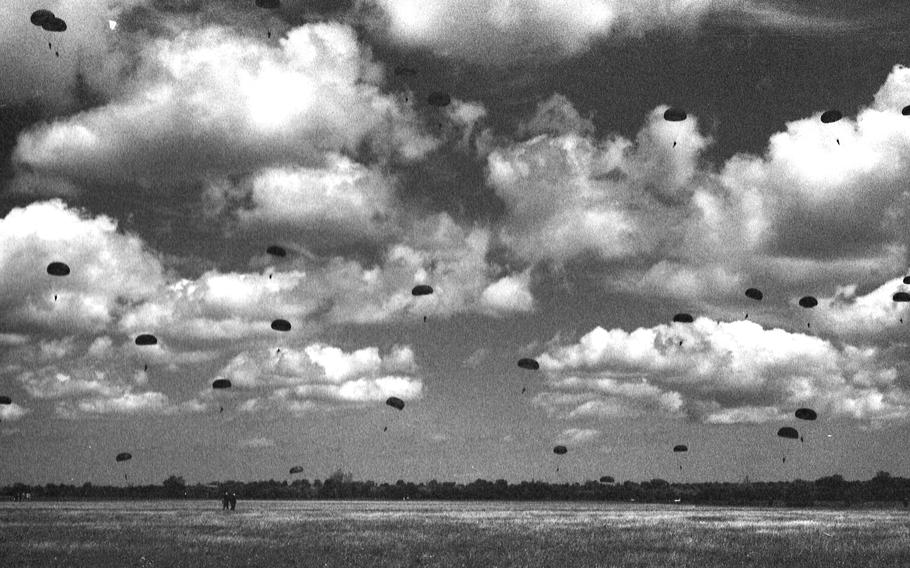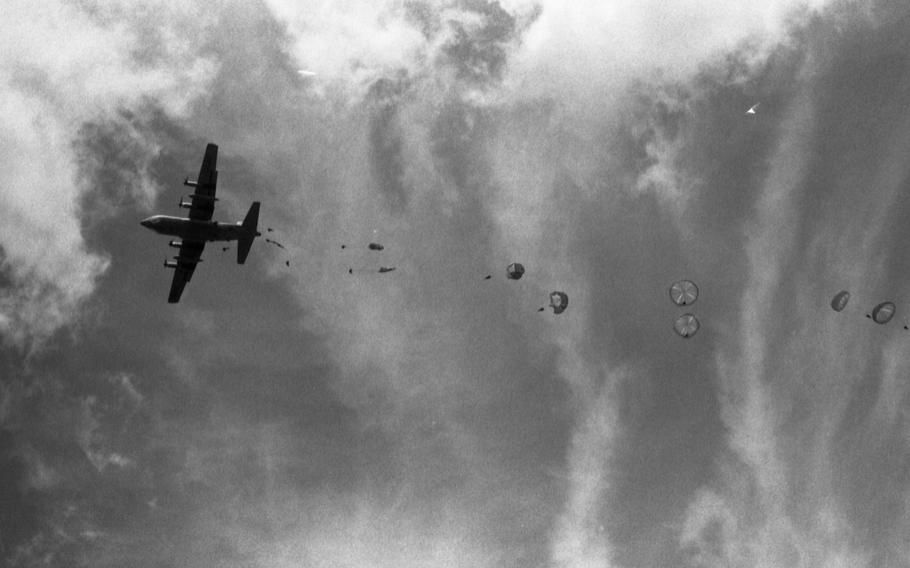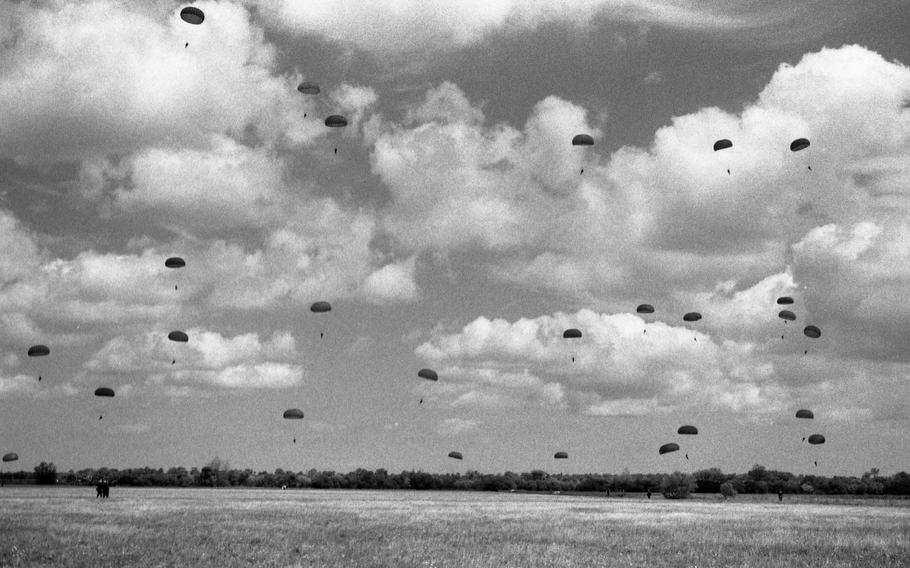
Parachutes glide toward earth as some 550 paratroopers reenacted the 101st Airborne Division D-Day jump, in Normandy, France, June 5, 1994. Nineteen of them were veterans of the actual landing 50 years ago who had fought to liberate the small town of Sainte-Mère-Église. They were the first to jump, together with 22 other World War II combat paratrooper veterans. (John Bohmer/Stars and Stripes)
In the months and days leading up to the 80th Anniversary of D Day, Stars and Stripes will be republishing a number of articles, as reported by its staff writers at the time. This article first appeared in the Stars and Stripes London edition, June 14, 1944. It is republished unedited in its original form.
(This story was written by Philip H. Bucknell, Stars and Stripes staff writer who landed with American paratroopers at Ste. Mere Eglise. Bucknell suffered a broken leg when he struck ground and now is convalescing at U.S. hospital in England.)
WITH AMERCAN AIRBORNE TROOPS, Ste. Mere Eglise, France, June 8 (delayed) — One-and-a-half hours after American paratroopers hit the DZ (Drop Zone) the American flag flew over the vital communications key-point of Ste. Mere Eglise.
The Americans swept into the town, winkling out the enemy from their strong points. They were reinforced by glider-borne troops. Simultaneously other units landed at other DZs in the vicinity and bottled up the road networks, holding down the line of attack for the troops which came in by sea.
Those amphibious forces were scheduled to reach us by noon D-Day — they came in some hours later. In the meantime the airborne troops held their positions against ever-increasing enemy counter-attacks, against artillery zeroed in on their positions and in the face of diminishing ammunition and non-existent rations. They held, and when at 10:30 AM on Wednesday the tanks came up, the two bridgeheads were waiting for their crossing.

Parachutes unfold as paratroopers jump out of a C-130. The paratroopers were some of the 550 reenacting the 101st Airborne Division D-Day jump. Nineteen of them were veterans of the actual landing 50 years ago who had fought to liberate the small town of Sainte-Mère-Église. They were the first to jump, together with 22 other World War II combat paratrooper veterans. (John Bohmer/Stars and Stripes)
‘Stand Up; Hook Up’
Now the land forces have moved on and beyond this town, and so have the airborne troops who survived the 32 hours of incessant and savage battle.
The trip across was easy, and the paratroopers took it easy. Most of the men in my plane slept until we hit the French coast. Then — ”Stand up; hook up” called the battalion commander, a lieutenant-colonel whose third combat jump this was. Flak started coming up at us as we crossed the coast, and by peering over his shoulder I could see yellow and green tracers reaching up at us. On the ground, apparently, was more opposition than we had expected.
The ground began to take the shape of the sand tables we had studied back in England. “This is it, fellers. Let’s go,” said the battalion commander quietly.
We went.
They were shooting at us as we came down, and we had to slip our chutes violently to escape the fire. That accelerates the speed of drop, and the impact of landing was too much for this reporter, who received a broken leg. This kind of injury was fairly common throughout the drops.
For the next seven and a half hours I watched the campaign from the position in which I landed. I could hear combat teams forming, moving stealthily to rendezvous points. There were angry bursts of machine-gun fire and the explosions of grenades. In the distance was the sound of mortar firing and way out towards sea was the sound of our naval fire.

Parachutes glide toward earth as some 550 paratroopers reenacted the 101st Airborne Division D-Day jump, June 5, 1994, in honor of D-Day’s 50th anniversary. (John Bohmer/Stars and Stripes)
Throughout the night came other paratroops, and gliders towed by the Ninth Troop Carrier Command swooped down searching for landing places.
I was not exactly lonely in my field, but I was mighty isolated.
In the morning I was found by the medical aidemen and they carried me in to a post near the chief CP, where I was able to keep up with the progress of the fighting.
The reports were good. The battalion commander, with whom I jumped, had collected a force of men and made a two-way penetration into Ste. Mere Eglise. Other forces were out on the flanks protecting communications and establishing road blocks.
Prisoners began to come in. Some were pathetic, obviously inferior coastal defense troops, either too young or too old. Then there were some impressed troops — non-Germans. Some of them fought well and furiously — they had been told we would slit their throats if we captured them.
Surrendered Without Fight
Others preferred to take a chance and surrendered without fight. One glider crew of medics, unarmed, of course, were surrounded by 42 Axis troops, fully armed with automatic weapons — they formally surrendered.
All that night the attack kept up, and by dawn the next morning the Germans had artillery within 800 yards of the chief command post, and snipers had infiltrated through to points of advantage not more than 300 yards away.
Soon after dawn Ninth Troop Carrier Command C47s swooped down daringly over our positions in face of continual fire and dropped us equipment bundles. Unfortunately, a lot of them dropped within sight of the enemy, who trained machine-gun fire on troops trying to reach them.
At 10 AM I was told by a staff officer that it seemed that the CP would have to be given up, and our troops would try to re-form nearer the town.
At 10:30 AM the first of the seaborne troops came through, and Sherman tanks began to arrive. And now we advance.
This is not the complete picture. It misses out too many things — about the glider artillery crew who landed and started firing within 20 minutes, and the mortar battered town of Ste. Mere Eglise that second morning when there were wrecks of German Mark IV tanks within 75 yards of the town center, but no closer. It misses the story of fighting at other points around the perimeter of our positions.
This is just the story of how an outnumbered, outgunned force of American paratroops and glider riders accomplished the mission they have trained so long to do, and then held their positions for 22 hours longer than the plan called for.